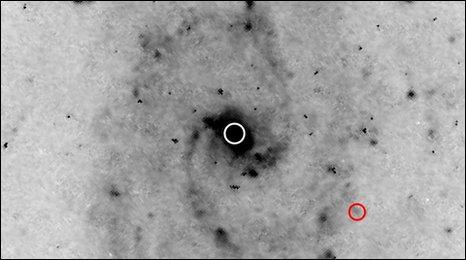Black hole 'hurled out of galaxy'
- Published

The red circle indicates where a black hole may be
A supermassive black hole may have been observed in the process of being hurled from its parent galaxy at high speed.
The finding comes from analysis of data collected by the US Chandra space X-ray observatory.
However, there are alternative explanations for the observation.
The work, by an international team of astronomers, has been published in the journal Monthly Notices of the Royal Astronomical Society.
Normally, each galaxy contains a supermassive black hole at its centre.
Given that these objects can have masses equivalent to one billion Suns, it takes a special set of conditions to cause this to happen.
High-speed exit
The authors believe this could be the result of the merger of two smaller black holes.
But there are alternative explanations for the bright X-ray source; it could also be a Type IIn supernova, or an ultra-luminous X-ray source (ULX) with an optical counterpart (which could represent several phenomena).
Simulations using supercomputers suggest that when this happens, the larger black hole that results is shot away at high speed.

Black holes may be expelled from their host galaxies after mergers
However, this depends on the direction and velocity at which the two black holes are rotating before their collision.
Marianne Heida of the University of Utrecht used data in the Chandra Source Catalogue to compare hundreds of thousands of sources of X-rays with the positions of millions of galaxies.
The material that falls into black holes heats up dramatically on its final journey, which often means that black holes are strong X-ray sources.
X-rays are also able to penetrate the dust and gas that obscures the centre of a galaxy, giving astronomers a clear view of the region around the black hole, with the bright source appearing as a star-like point.
Looking at one galaxy in the Catalogue, Ms Heida noticed that the point of light was offset from the centre and yet was so bright that it could be associated with a supermassive black hole.
Ms Heida said: "We have found many more objects in this strange class of X-ray sources. With Chandra we should be able to make the accurate measurements we need to pinpoint them more precisely and identify their nature."